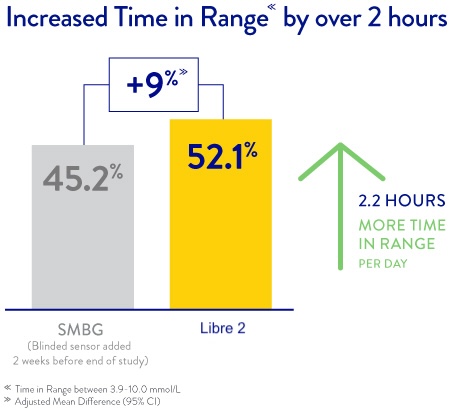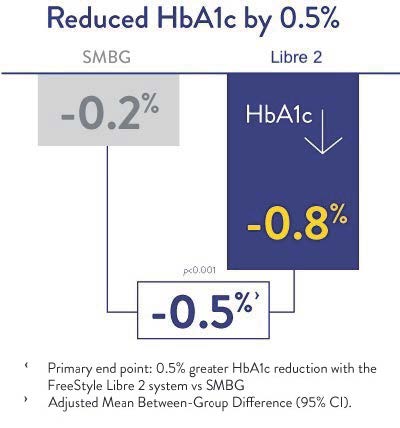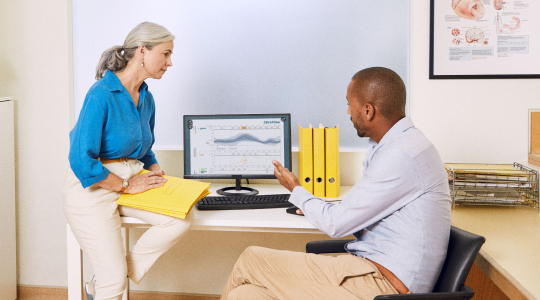Increased Time in Range
The FreeStyle Libre systems are proven to increase %TIR*,1
2.2 hours more Time in Range per day in T1D1
An independent study published in the New England Journal of Medicine shows that Libre 2 users increased their Time in Range by over 2 hours per day.
- 156 people with T1D ≥16 years with HbA1c >7.5% to 7.5%-11% participated in a randomised, controlled study
- Libre 2 users spent 2.2 hours more time in range per day at 6 months of use vs those using self-monitored blood glucose

Reduced HbA1c
The FreeStyle Libre systems are clinically proven to significantly reduce HbA1c*,1-3
HbA1c reduction in T1D
Significant HbA1c reduction in T1D1
The same independent study shows that Libre users reduced their HbA1c by 0.5% compared to self-monitored blood glucose at 6 months of use.

HbA1c reduction in T2D on MDIs
0.82%
HbA1c reduction for T2DM on MDIs
at 10 weeks of use2
at 10 weeks of use2
vs -0.33% with BGM (p=0.005)
RCT of n=101 people with T2DM on MDI therapy
0.9%
HbA1c reduction for T2DM
on rapid- or short-acting insulin3
on rapid- or short-acting insulin3
p<0.0001 vs baseline
Meta-analysis of data from 18 medical centres in Austria, France and Germany
n=363
Reduced time in hypoglycaemia
The FreeStyle Libre systems are clinically proven to reduce time in hypoglycaemia in T1D1 and T2D on MDIs*,4
T1D
43 minutes
less time in hypoglycaemia per day1
T2D on MDIs
43%
reduction in time spent in hypoglycaemia4
(<3.9 mmol/L)
(p=0.0006)
Making Better Choices
The Libre Products helps patients with T1D and T2D make better choices
Better understanding of glucose fluctuations:
Real World data showed that 95% of patients with T1D and T2D using the FreeStyle Libre systems* have a better understanding of their glucose fluctuations.5
Lifestyle modifications can help lower HbA1c
Patients with T2D who make lifestyle changes, such as diet and physical activity, see improved glucose control.6

Improved Glycaemic Control in ChildrenѰ
1 hr/day
increase in time in range
(3.9–10.0 mmol/L)
0.4%
reduction in HbA1c7
1.2 hr/day
less time spent in hyperglycaemia7
(>10 mmol/L) with no significant increase in time spent in hypoglycaemia (<3.9 mmol/L)
90%
of children and teenagers agreed that the FreeStyle Libre systems* did not get in the way of daily activities7
Additional Resources
Real-World Data
Analysing the impact of the Libre Products on the lives of real users.
Educational Modules
Learn more about Time in Range and the Libre Products through our Healthcare Professional education modules.
Webinars
We offer various on-demand webinars for Healthcare Professionals.
Webcast Series
Learn more about Time in Range in our CME accredited three-module webcast series.
Training Resources
Explore our training resources to help you to help your patients understand Time in Range better.
References & Disclaimers
Images are for illustrative purposes only. Not real patient or data.
* FreeStyle Libre systems refers to the FreeStyle Libre 2 and FreeStyle Libre 3 systems. The data from this study was collected using the FreeStyle Libre 2 system. FreeStyle Libre 3 system has the same features as the FreeStyle Libre 2 system therefore the study data is applicable to both products.
Ѱ For children aged 4-12 using the FreeStyle Libre 2 sensor or for children aged 2-12 using the FreeStyle Libre 2 plus or FreeStyle Libre 3 plus sensor, a caregiver at least 18 years old is responsible for supervising, managing, and assisting them in using the FreeStyle Libre 2 or FreeStyle Libre 3 systems and interpreting its readings.
1. Leelarathna, L. N Engl J Med. (2022): DOI: 10.1056/NEJMoa2205650.
2. Yaron M, et al. Effect of flash glucose monitoring technology on glycemic control and treatment satisfaction in patients with type 2 diabetes. Diabetes Care 2019;42(7):1178–84.
3. Kröger J, et al. Three European retrospective real-world chart review studies to determine the effectiveness of flash glucose monitoring on HbA1c in adults with type 2 diabetes. Diabetes Ther 2020;11(1):279–91.
4. Haak T, et al. Flash glucose-sensing technology as a replacement for blood glucose monitoring for the management of insulin-treated type 2 diabetes: a multicenter, open-label randomized controlled trial. Diabetes Ther 2017;8(1):55–73.
5. Fokkert M, van Dijk P, Edens M, et al. Improved well-being and decreased disease burden after 1-year use of flash glucose monitoring (FLARE-NL4). BMJ Open Diab Res Care. 2019. https://doi:10.1136/bmjdrc-2019-000809.
6. American Diabetes Association Professional Practice Committee. 5. Facilitating behavior change and well-being to improve health outcomes: Standards of Medical Care in Diabetes—2022. Diabetes Care 2022;45 (Suppl. 1):S60–S82.
7. Campbell FM, et al. Outcomes of using flash glucose monitoring technology by children and young people with type 1 diabetes in a single arm study. Pediatr Diabetes 2018;19(7):1294–301.
ADC-63838 V6.0



